人教版高中英语选修10 Unit 5 Enjoying novels Grammar 课件(31张PPT)
文档属性
| 名称 | 人教版高中英语选修10 Unit 5 Enjoying novels Grammar 课件(31张PPT) |

|
|
| 格式 | zip | ||
| 文件大小 | 492.0KB | ||
| 资源类型 | 教案 | ||
| 版本资源 | 人教版(新课程标准) | ||
| 科目 | 英语 | ||
| 更新时间 | 2020-07-01 08:25:23 | ||
图片预览

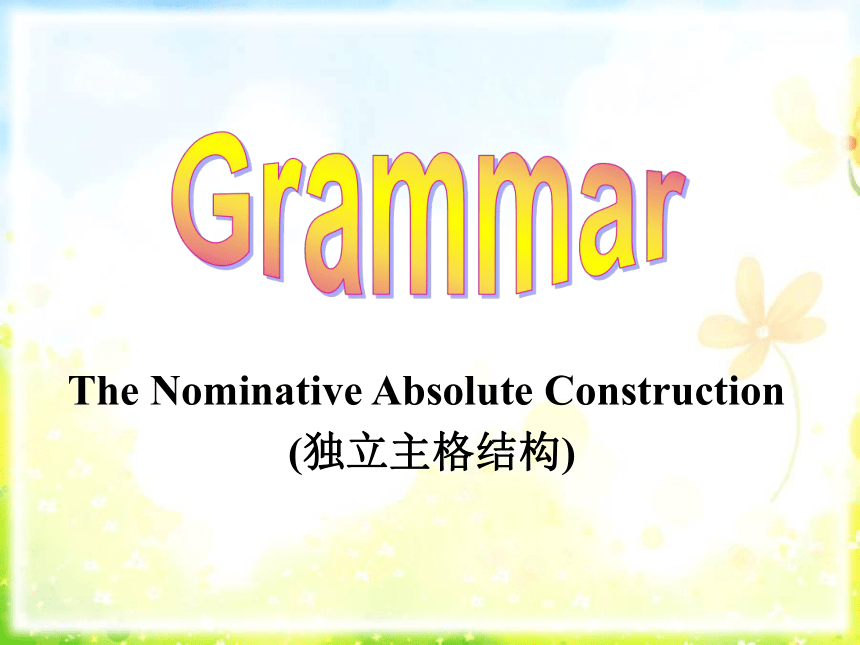




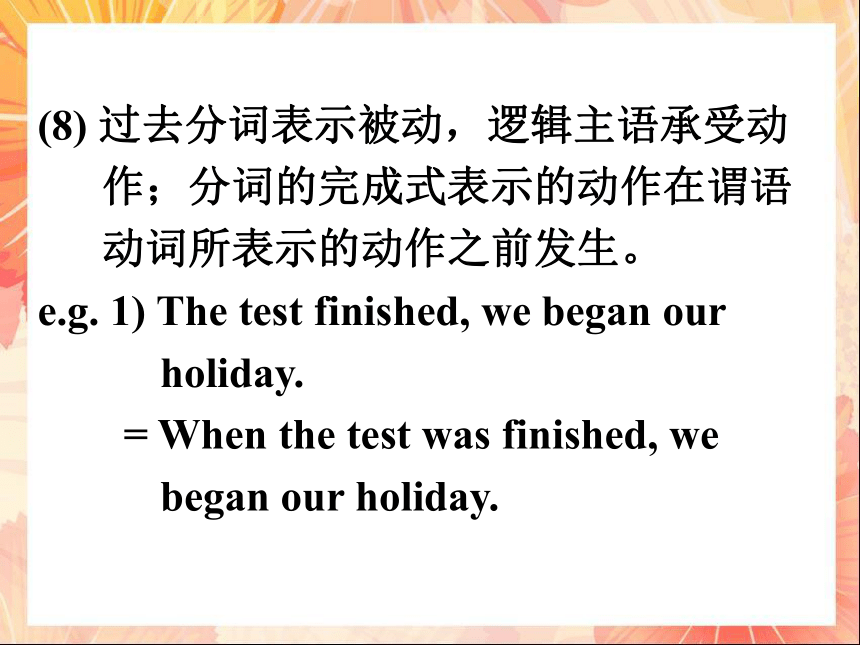
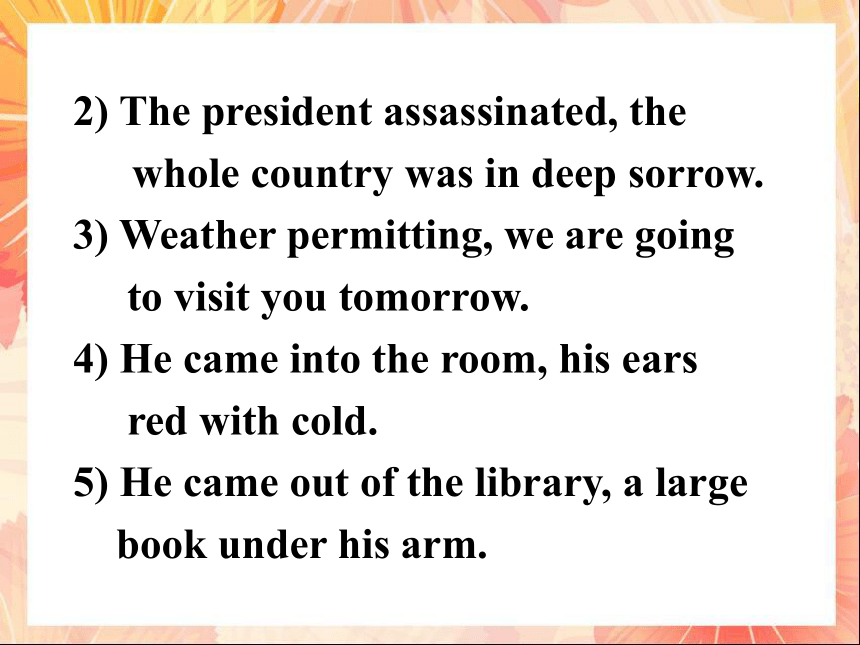

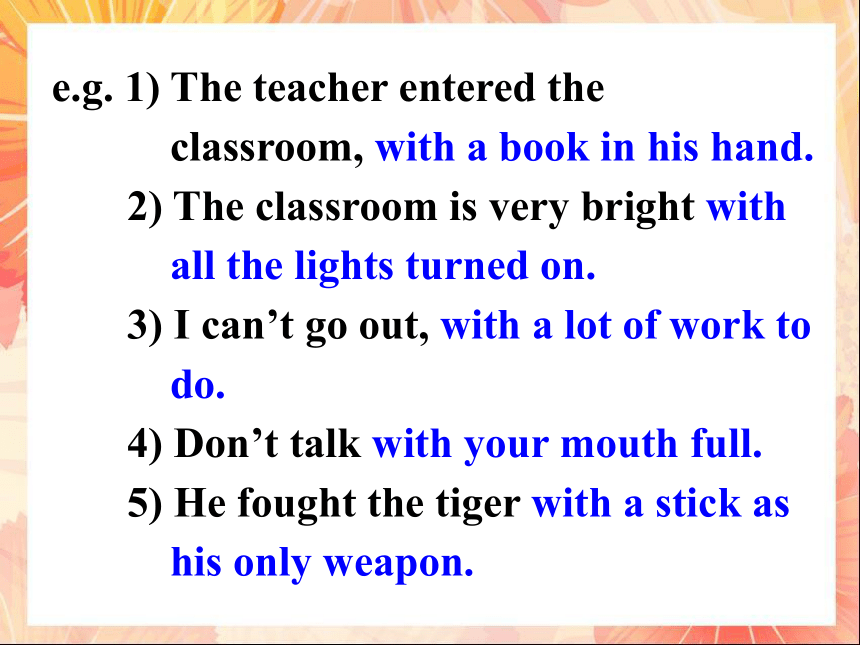
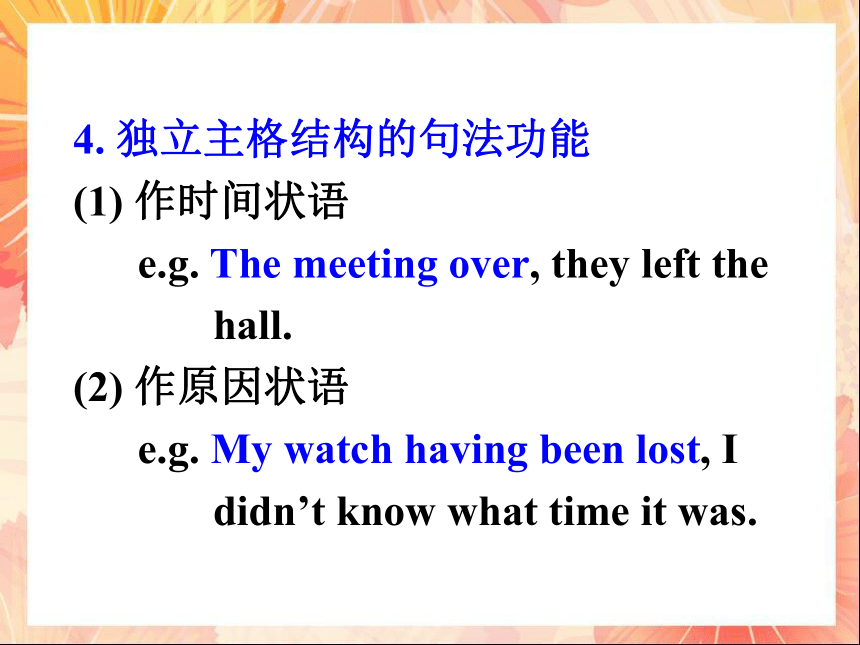

文档简介
(共31张PPT)
The
Nominative
Absolute
Construction
(独立主格结构)
1.
构成:
独立主格结构由名词或代词加上其他成分(分词,
不定式,
名词,
代词,
形容词,
副词或介词短语)构成,
在语法上是一个独立的短语,
不是句子,
在意思上依附于整个句子。构成如下:
The
Nominative
Absolute
Construction
(独立主格结构)
(1)
名词(代词)
+
现在分词,
过去分词
(2)
名词(代词)
+
形容词
(3)
名词(代词)
+
副词
(4)
名词(代词)
+
不定式
(5)
名词(代词)
+
介词短语
2.
独立主格结构的特点:
(1)
独立主格结构的作用相当于状语从句,
可表示时间,
原因,
条件,
行为方式或伴随情况;
(2)
独立主格结构可置于句首,
也可以放在句尾;
(3)
独立主格结构主要用于书面语;
(4)
独立主格结构的逻辑主语与句中的语法主语不同,
不指同一个人或同一事物;
(5)
独立主格结构的逻辑主语与句子的主语不同,
它独立存在;
(6)
名词或代词与后面的分词,
形容词,
副词,
不定式,
介词等是主谓关系;
(7)
独立主格结构一般有逗号与主句分
开;
(8)
过去分词表示被动,逻辑主语承受动
作;分词的完成式表示的动作在谓语
动词所表示的动作之前发生。
e.g.
1)
The
test
finished,
we
began
our
holiday.
=
When
the
test
was
finished,
we
began
our
holiday.
2)
The
president
assassinated,
the
whole
country
was
in
deep
sorrow.
3)
Weather
permitting,
we
are
going
to
visit
you
tomorrow.
4)
He
came
into
the
room,
his
ears
red
with
cold.
5)
He
came
out
of
the
library,
a
large
book
under
his
arm.
3.
with的复合结构作独立主格
表伴随时,
既可用分词的独立结构,
也可
用with的复合结构。其结构如下:
(1)
with+名词/代词宾格+介词短语
(2)
with+名词/代词宾格+分词
(3)
with+名词/代词宾格+不定式
(4)
with+名词/代词宾格+形容词/副词
(5)
with+名词/代词宾格+名词
e.g.
1)
The
teacher
entered
the
classroom,
with
a
book
in
his
hand.
2)
The
classroom
is
very
bright
with
all
the
lights
turned
on.
3)
I
can’t
go
out,
with
a
lot
of
work
to
do.
4)
Don’t
talk
with
your
mouth
full.
5)
He
fought
the
tiger
with
a
stick
as
his
only
weapon.
4.
独立主格结构的句法功能
(1)
作时间状语
e.g.
The
meeting
over,
they
left
the
hall.
(2)
作原因状语
e.g.
My
watch
having
been
lost,
I
didn’t
know
what
time
it
was.
(3)
作条件状语
e.g.
Time
permitting,
I
shall
go
to
the
cinema
with
you.
(4)
描述伴随行为或补充说明
e.g.
Mary
entered
the
room,
with
a
big
apple
in
her
hand.
He
stood
there,
with
his
hands
in
his
pockets.
1.
Rewrite
the
following
sentences,
making
them
more
colloquial.
1)
The
last
bus
having
gone,
I
had
to
walk
home.
I
had
to
walk
home
because
the
last
bus
had
gone.
2)
All
possibilities
considered,
I
think
we
ought
to
make
a
decision.
I
think
we
ought
to
make
a
decision
after
considering
all
possibilities.
3)
All
the
desk
and
chairs
having
been
mended,
the
carpenter
packed
up
his
tools
and
went
home.
The
carpenter
packed
up
his
tools
and
went
home
after
all
the
desks
and
chairs
had
been
mended.
4)
All
the
compositions
having
been
collected,
Miss
Gao
sent
the
class
home.
Miss
Gao
sent
the
class
home
once
all
the
compositions
had
been
collected.
2.
Read
and
translate
the
passage
into
Chinese.
Underline
the
examples
of
the
nominative
absolute
construction
in
the
passage.
Then
rewrite
it
using
a
more
colloquial
style.
This
machine
can
help
you
sleep
by
removing
all
problems
from
your
mind
and
providing
you
with
calm
and
peace.
Personality
permitting,
the
machine
puts
you
to
sleep
within
one
hour.
Volunteers
are
asked
to
lie
on
a
bed,
with
their
hands
by
their
sides.
The
relaxometer
is
placed
around
their
heads.
Quiet
and
calming
music
being
played,
the
supervisor
monitors
the
effect
of
the
relaxometer
on
the
patient.
The
volunteer
becoming
sleepy,
the
supervisor
arranges
for
the
bed
to
rock
gently.
Regular
breathing
beginning,
it
is
clear
that
the
relaxometer
is
doing
its
job
well.
It
is
expected
that
only
the
most
difficult
cases
will
remain
awake,
the
supervisor
being
in
constant
attendance
to
make
sure
there
is
no
accident.
Coming
with
a
lifetime
guarantee,
this
machine
can
be
rented
or
brought
in
all
big
supermarkets.
____
I
attended
the
meeting
instead
of
him
last
Monday.
A.
He
was
ill
B.
His
being
ill
C.
Him
being
ill
D.
He
being
ill
3.
Choose
the
best
answers.
2.
____,
I’ll
go
over
all
these
lessons
before
the
exam.
A.
If
time
permit
will
B.
Time
permits
C.
If
time
permitted
D.
Time
permitting
3.
_____,
he
drew
a
conclusion.
A.
The
experiment
B.
The
experiment
making
C.
The
experiment
having
been
done
D.
The
experiment
made
4.
_____
tomorrow,
I
couldn’t
go
to
the
cinema
tonight.
A.
The
exam
to
be
held
B.
The
exam
will
hold
C.
The
exam
holds
D.
The
exam
holding
5.
______,
her
paper
is
of
greater
value
than
yours.
A.
All
things
be
considered
B.
All
things
considered
C.
All
things
having
considering
D.
All
things
considering
6.
A
new
technique
___,
the
yields
as
a
whole
increased
by
20
percent.
A.
working
out
B.
having
worked
out
C.
having
been
worked
out
D.
to
have
been
worked
out
7.
The
decision
____,
the
next
problem
was
how
to
make
a
good
a
good
plan.
A.
having
made
B.
having
been
making
C.
having
been
made
D.
been
made
8.
The
teacher
walked
into
the
classroom
____.
A.
with
a
book
in
hand
B.
hand
with
a
book
C.
being
with
a
book
in
hand
D.
to
have
a
book
in
hand
9.
____
no
homework
left,
the
pupils
could
do
whatever
they
liked.
A.
There
being
B.
There
had
C.
There
to
be
D.
There
having
Review
the
nominative
absolute
construction.
The
Nominative
Absolute
Construction
(独立主格结构)
1.
构成:
独立主格结构由名词或代词加上其他成分(分词,
不定式,
名词,
代词,
形容词,
副词或介词短语)构成,
在语法上是一个独立的短语,
不是句子,
在意思上依附于整个句子。构成如下:
The
Nominative
Absolute
Construction
(独立主格结构)
(1)
名词(代词)
+
现在分词,
过去分词
(2)
名词(代词)
+
形容词
(3)
名词(代词)
+
副词
(4)
名词(代词)
+
不定式
(5)
名词(代词)
+
介词短语
2.
独立主格结构的特点:
(1)
独立主格结构的作用相当于状语从句,
可表示时间,
原因,
条件,
行为方式或伴随情况;
(2)
独立主格结构可置于句首,
也可以放在句尾;
(3)
独立主格结构主要用于书面语;
(4)
独立主格结构的逻辑主语与句中的语法主语不同,
不指同一个人或同一事物;
(5)
独立主格结构的逻辑主语与句子的主语不同,
它独立存在;
(6)
名词或代词与后面的分词,
形容词,
副词,
不定式,
介词等是主谓关系;
(7)
独立主格结构一般有逗号与主句分
开;
(8)
过去分词表示被动,逻辑主语承受动
作;分词的完成式表示的动作在谓语
动词所表示的动作之前发生。
e.g.
1)
The
test
finished,
we
began
our
holiday.
=
When
the
test
was
finished,
we
began
our
holiday.
2)
The
president
assassinated,
the
whole
country
was
in
deep
sorrow.
3)
Weather
permitting,
we
are
going
to
visit
you
tomorrow.
4)
He
came
into
the
room,
his
ears
red
with
cold.
5)
He
came
out
of
the
library,
a
large
book
under
his
arm.
3.
with的复合结构作独立主格
表伴随时,
既可用分词的独立结构,
也可
用with的复合结构。其结构如下:
(1)
with+名词/代词宾格+介词短语
(2)
with+名词/代词宾格+分词
(3)
with+名词/代词宾格+不定式
(4)
with+名词/代词宾格+形容词/副词
(5)
with+名词/代词宾格+名词
e.g.
1)
The
teacher
entered
the
classroom,
with
a
book
in
his
hand.
2)
The
classroom
is
very
bright
with
all
the
lights
turned
on.
3)
I
can’t
go
out,
with
a
lot
of
work
to
do.
4)
Don’t
talk
with
your
mouth
full.
5)
He
fought
the
tiger
with
a
stick
as
his
only
weapon.
4.
独立主格结构的句法功能
(1)
作时间状语
e.g.
The
meeting
over,
they
left
the
hall.
(2)
作原因状语
e.g.
My
watch
having
been
lost,
I
didn’t
know
what
time
it
was.
(3)
作条件状语
e.g.
Time
permitting,
I
shall
go
to
the
cinema
with
you.
(4)
描述伴随行为或补充说明
e.g.
Mary
entered
the
room,
with
a
big
apple
in
her
hand.
He
stood
there,
with
his
hands
in
his
pockets.
1.
Rewrite
the
following
sentences,
making
them
more
colloquial.
1)
The
last
bus
having
gone,
I
had
to
walk
home.
I
had
to
walk
home
because
the
last
bus
had
gone.
2)
All
possibilities
considered,
I
think
we
ought
to
make
a
decision.
I
think
we
ought
to
make
a
decision
after
considering
all
possibilities.
3)
All
the
desk
and
chairs
having
been
mended,
the
carpenter
packed
up
his
tools
and
went
home.
The
carpenter
packed
up
his
tools
and
went
home
after
all
the
desks
and
chairs
had
been
mended.
4)
All
the
compositions
having
been
collected,
Miss
Gao
sent
the
class
home.
Miss
Gao
sent
the
class
home
once
all
the
compositions
had
been
collected.
2.
Read
and
translate
the
passage
into
Chinese.
Underline
the
examples
of
the
nominative
absolute
construction
in
the
passage.
Then
rewrite
it
using
a
more
colloquial
style.
This
machine
can
help
you
sleep
by
removing
all
problems
from
your
mind
and
providing
you
with
calm
and
peace.
Personality
permitting,
the
machine
puts
you
to
sleep
within
one
hour.
Volunteers
are
asked
to
lie
on
a
bed,
with
their
hands
by
their
sides.
The
relaxometer
is
placed
around
their
heads.
Quiet
and
calming
music
being
played,
the
supervisor
monitors
the
effect
of
the
relaxometer
on
the
patient.
The
volunteer
becoming
sleepy,
the
supervisor
arranges
for
the
bed
to
rock
gently.
Regular
breathing
beginning,
it
is
clear
that
the
relaxometer
is
doing
its
job
well.
It
is
expected
that
only
the
most
difficult
cases
will
remain
awake,
the
supervisor
being
in
constant
attendance
to
make
sure
there
is
no
accident.
Coming
with
a
lifetime
guarantee,
this
machine
can
be
rented
or
brought
in
all
big
supermarkets.
____
I
attended
the
meeting
instead
of
him
last
Monday.
A.
He
was
ill
B.
His
being
ill
C.
Him
being
ill
D.
He
being
ill
3.
Choose
the
best
answers.
2.
____,
I’ll
go
over
all
these
lessons
before
the
exam.
A.
If
time
permit
will
B.
Time
permits
C.
If
time
permitted
D.
Time
permitting
3.
_____,
he
drew
a
conclusion.
A.
The
experiment
B.
The
experiment
making
C.
The
experiment
having
been
done
D.
The
experiment
made
4.
_____
tomorrow,
I
couldn’t
go
to
the
cinema
tonight.
A.
The
exam
to
be
held
B.
The
exam
will
hold
C.
The
exam
holds
D.
The
exam
holding
5.
______,
her
paper
is
of
greater
value
than
yours.
A.
All
things
be
considered
B.
All
things
considered
C.
All
things
having
considering
D.
All
things
considering
6.
A
new
technique
___,
the
yields
as
a
whole
increased
by
20
percent.
A.
working
out
B.
having
worked
out
C.
having
been
worked
out
D.
to
have
been
worked
out
7.
The
decision
____,
the
next
problem
was
how
to
make
a
good
a
good
plan.
A.
having
made
B.
having
been
making
C.
having
been
made
D.
been
made
8.
The
teacher
walked
into
the
classroom
____.
A.
with
a
book
in
hand
B.
hand
with
a
book
C.
being
with
a
book
in
hand
D.
to
have
a
book
in
hand
9.
____
no
homework
left,
the
pupils
could
do
whatever
they
liked.
A.
There
being
B.
There
had
C.
There
to
be
D.
There
having
Review
the
nominative
absolute
construction.
